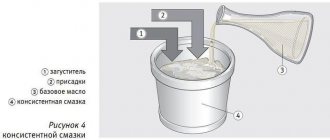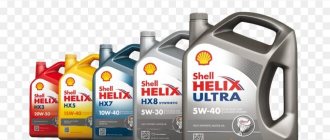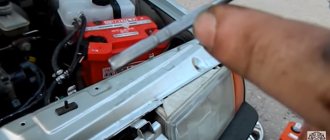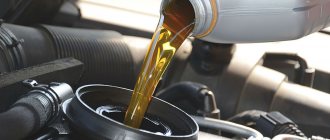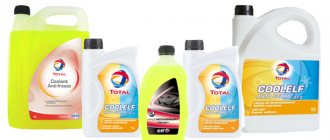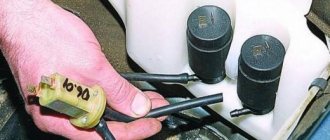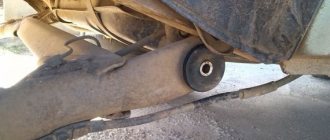06/24/2021 17,048 Consultation with a specialist
Author: Ivan Baranov
Good day! It's time to lubricate the crosspieces in my car, but I just can't decide how best to do it. Friends advised me to use a syringe, but I had never encountered this before. Please tell me which grease syringe is better to choose so that it is convenient to use? (Egor Polishchuk).
Hello, Egor. Here it’s more about choosing the nozzle that needs to reach the grease fitting on the cross. The gun itself, in principle, can be chosen any way, but in practice, car enthusiasts most often use a plunger syringe. We invite you to familiarize yourself with the material in order to decide on the choice of the syringe itself.
Plunger ShS black [ Hide ]
Scope of application
A grease gun is a special device designed to supply grease to components under high pressure. Lubricant enters the mechanism through built-in grease nipples, or it is applied directly. As a rule, this device is used to service complex components and mechanisms that operate in high wear conditions.
Lubricant syringes are widely used among motorists. They are used to service hard-to-reach and more convenient components and mechanisms: crosspieces, hubs, hinges, bearings, etc. Thanks to the syringe, there is no need to disassemble bulky and complex units, since the flexible tip of the device allows you to easily get to a hard-to-reach lubrication point.
Often, such syringes are used to change engine oil or transmission fluid in a gearbox. This is due to the fact that the oil enters the unit under pressure, which allows for better lubrication of all working elements. The syringe also makes maintenance cleaner.
What's the result?
As you can see, there are several types of grease guns. It is important to immediately determine how often and for what purposes the device will be used. In some cases, it is enough to purchase a simple plunger pistol grease gun, a manual lever syringe, etc. In others, the optimal solution would be a pneumatic syringe for injecting lubricant, which will speed up the process of lubrication of parts.
One way or another, it is important to buy quality equipment. For this reason, it is recommended to opt for well-known manufacturers (for example, GROZ, Intertool), and not to purchase the cheapest products, focusing only on cost.
We also recommend reading the article on how to lubricate battery terminals. From this article you will learn about why lubricating battery terminals is needed, how to lubricate the terminals, and what lubrication materials are best to use.
It often happens that it is better to buy a simpler and higher-quality version of a well-known brand that is more expensive than a cheap analogue of professional equipment (for example, a pneumatic syringe for the price of a simple manual one). In fact, cheap devices have a short service life and low pressure.
This can make them difficult to use, and you may soon need to buy a new replacement grease gun. To avoid such problems, you should select the equipment correctly, while the desire to save money when purchasing such a device is better relegated to the background.
Classification
By type of design, mechanical and pneumatic syringes can be distinguished.
Mechanical devices are easier to operate. To lubricate any element, you need to place lubricant in the volume of the syringe and press the handle several times. The properties of mechanical devices differ in tank volume and operating pressure. The larger the volume, the longer the filled lubricant will last. The pressure determines how intensively the material will be supplied. The higher it is, the stronger the lubricant will be dosed.
Pneumatic devices operate on compressed air, which is taken from a compressor. Such devices are convenient because no effort is required to supply lubricant. They are less common and are used mainly at car service stations and in various industrial production. Pneumatic syringes differ among themselves in weight, lubricant flow rate and operating pressure.
Mechanical devices can be divided into plunger, battery and screw.
Plunger
A plunger syringe, or as it is also called a manual syringe, is a movable body that is connected to a conductive tube with a suction element and a piston. Thanks to this design, the pumping angle of the lever is reduced. At the end of the device there is a high-pressure cylinder with a discharge valve.
The lubricant is placed in the syringe body. When the device is activated, the tip interacts with the oiler. After this, the lubricant enters the high pressure cylinder and flows out.
Rechargeable
The cordless grease gun works thanks to a battery that is built into the device. The energy drives a piston, which forces lubricant through a tube to the surface. Depending on the battery capacity, the power of the devices and their charging time vary. There are syringes that can be powered from a car's cigarette lighter.
Screw
A screw-type grease gun differs from a plunger-type one by a much larger volume. At one end of such a device there is a nozzle for supplying lubricant, and at the other there is a special screw. During the tightening process, it interacts with the piston, which supplies lubricant due to excess pressure. This type of syringe is used to lubricate holes and threaded connections.
Screw and pneumatic syringe - features
Screw-type lubricants are most often used to lubricate holes and thread connections; they are not suitable for ball-type grease fittings. A distinctive feature of this type of device is a special fitting that is attached to the tip. During lubrication, the bolt is unscrewed and the fitting is installed. Next, use a syringe to squeeze out the lubricant.
The pneumatic type is also called a crosspiece grease gun. The design has an automatic drive and a pistol. When you pull the trigger, without using strong physical force, the lubricant flows out under high pressure. However, the power may vary depending on the manufacturer and model of the device. On average it varies from 2.6 bar to 10.3 bar. This must be taken into account when choosing a device. The operating temperature may also differ; it can be in the range from -20 °C to +50 °C. And the weight of the structure itself is small, about 2 kg.
How to fill a syringe with a cartridge?
In order to place a lubricant cartridge into the volume of the syringe, you must first unscrew the cap of the device. Next, you should completely pull out the metal rod with the piston, which acts on the cartridge and supplies the lubricant out and fix it.
After this, you need to prepare a package of lubricant. You need to remove the cap from it. Before use, it is recommended to hold the cartridge upside down for some time. This is done so that the lubricant is directly at the nozzle.
Install the cartridge with the lubricant facing the nozzle. The packaging must match the end of the device body. Screw on the device cover. Next, you need to release the rod and press it into the body while simultaneously working with the handle of the device. This is done in order to get rid of excess air. As soon as the lubricant appears from the nozzle, stop working on the handle.
Next, we simultaneously tighten the body and cap of the syringe, check that the rod and piston interact with the cartridge and see if the lubricant comes out when pressing on the syringe handle.
Purpose
Some vehicle components are located in difficult places where access to filler funnels and crankcase drain holes is difficult. An oil syringe is designed to supply lubricant to hard-to-reach places in mechanisms, gearboxes, and transmission units. Also, if the necessary options are available, a plastic syringe for filling oil can perform the function of collecting waste, which allows servicing the units without disassembling or dismantling.
Some specialists use tools to lubricate hard-to-reach threaded connections.
What happens if you fill in engine oil instead of transmission oil?
Before adding any lubricant, it is recommended to refer to the vehicle’s operating instructions. Some old-type manual transmissions can easily survive for a certain time on motor oil, but whether it is possible to pour motor oil into the gearbox of your car in principle, you need to find out in the manual for the car. The device resource and service life will noticeably decrease, and this is the best that can happen. By regularly using lubricants for purposes other than their intended purpose, you can cause the gearbox to fail.
The compounds cannot replace each other, much less mix, except in emergency situations, when there is no lubricant in the box at all, there is no transmission product at hand, and you still need to use something to get to your destination. Such a replacement is justified, but can only be a temporary solution.
Transmission oil change intervals
Transmission oil is replaced when the additive package loses its performance characteristics and efficiency. As a result, the components do not provide the necessary protection to functioning surfaces. Foam begins to form on the substance, and in some cases the main gear seizes. All this can lead to the appearance of an unpleasant gear hum in the gearbox differential. The humming gets stronger over time and, eventually, after a run of about 500 km, the gear teeth begin to break down. The result is that the gearbox jams. As a rule, this applies to all-wheel drive and front-wheel drive vehicles.
Models with rear-wheel drive and a manual transmission allow you to use transmission oil without problems for 10–20 thousand km longer. At the same time, it retains its properties, since there are no significant temperature loads on the gearbox. Change the oil at the same time as replacing it in the gearbox. This procedure is needed to eliminate contaminants that form during the operation of gears. Along with the lubricant, chips and other debris are removed from the gearbox housing during draining.
The transmission oil change interval is once every 60 thousand km. If your driving style is intense (that is, rapid acceleration and sharp braking), then the lubricant must be changed every 40 thousand kilometers. Moreover, these recommendations should be followed regardless of the total mileage.
There are car models whose gearbox housing is not equipped with a drain plug. Therefore, lubricant is poured into them for the entire service life.
In the modern automotive industry, CVT transmissions have become very popular. Despite their belonging to the automatic type, the internal structure is different. CVT gearboxes operate under severe temperature conditions, so instead of the usual lubricant used for automatic transmissions, a special one is poured into them.
Transmission fluid in CVTs is replaced after 50 thousand km. If aggressive driving is expected, the period is reduced to 30 thousand km. You should strictly adhere to the recommendations for replacing CVT fluid, because additives lose their properties very quickly. This is due to the fact that the variator belt is constantly under heavy load and operates in harsh temperature conditions.

